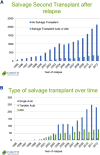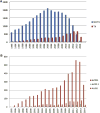American Society of Blood and Marrow Transplantation, European Society of Blood and Marrow Transplantation, Blood and Marrow Transplant Clinical Trials Network, and International Myeloma Working Group Consensus Conference on Salvage Hematopoietic Cell Transplantation in Patients with Relapsed Multiple Myeloma
- PMID: 26428082
- PMCID: PMC4757494
- DOI: 10.1016/j.bbmt.2015.09.016
American Society of Blood and Marrow Transplantation, European Society of Blood and Marrow Transplantation, Blood and Marrow Transplant Clinical Trials Network, and International Myeloma Working Group Consensus Conference on Salvage Hematopoietic Cell Transplantation in Patients with Relapsed Multiple Myeloma
Abstract
In contrast to the upfront setting in which the role of high-dose therapy with autologous hematopoietic cell transplantation (HCT) as consolidation of a first remission in patients with multiple myeloma (MM) is well established, the role of high-dose therapy with autologous or allogeneic HCT has not been extensively studied in MM patients relapsing after primary therapy. The International Myeloma Working Group together with the Blood and Marrow Transplant Clinical Trials Network, the American Society of Blood and Marrow Transplantation, and the European Society of Blood and Marrow Transplantation convened a meeting of MM experts to: (1) summarize current knowledge regarding the role of autologous or allogeneic HCT in MM patients progressing after primary therapy, (2) propose guidelines for the use of salvage HCT in MM, (3) identify knowledge gaps, (4) propose a research agenda, and (5) develop a collaborative initiative to move the research agenda forward. After reviewing the available data, the expert committee came to the following consensus statement for salvage autologous HCT: (1) In transplantation-eligible patients relapsing after primary therapy that did NOT include an autologous HCT, high-dose therapy with HCT as part of salvage therapy should be considered standard; (2) High-dose therapy and autologous HCT should be considered appropriate therapy for any patients relapsing after primary therapy that includes an autologous HCT with initial remission duration of more than 18 months; (3) High-dose therapy and autologous HCT can be used as a bridging strategy to allogeneic HCT; (4) The role of postsalvage HCT maintenance needs to be explored in the context of well-designed prospective trials that should include new agents, such as monoclonal antibodies, immune-modulating agents, and oral proteasome inhibitors; (5) Autologous HCT consolidation should be explored as a strategy to develop novel conditioning regimens or post-HCT strategies in patients with short (less than 18 months remissions) after primary therapy; and (6) Prospective randomized trials need to be performed to define the role of salvage autologous HCT in patients with MM relapsing after primary therapy comparing it to "best non-HCT" therapy. The expert committee also underscored the importance of collecting enough hematopoietic stem cells to perform 2 transplantations early in the course of the disease. Regarding allogeneic HCT, the expert committee agreed on the following consensus statements: (1) Allogeneic HCT should be considered appropriate therapy for any eligible patient with early relapse (less than 24 months) after primary therapy that included an autologous HCT and/or high-risk features (ie, cytogenetics, extramedullary disease, plasma cell leukemia, or high lactate dehydrogenase); (2) Allogeneic HCT should be performed in the context of a clinical trial if possible; (3) The role of postallogeneic HCT maintenance therapy needs to be explored in the context of well-designed prospective trials; and (4) Prospective randomized trials need to be performed to define the role salvage allogeneic HCT in patients with MM relapsing after primary therapy.
Keywords: Myeloma; Salvage therapy; Stem cell transplantation.
Copyright © 2015 American Society for Blood and Marrow Transplantation. Published by Elsevier Inc. All rights reserved.
Figures




Similar articles
-
Hematopoietic Stem Cell Transplantation for Multiple Myeloma: Guidelines from the American Society for Blood and Marrow Transplantation.Biol Blood Marrow Transplant. 2015 Jul;21(7):1155-66. doi: 10.1016/j.bbmt.2015.03.002. Epub 2015 Mar 11. Biol Blood Marrow Transplant. 2015. PMID: 25769794 Review.
-
Autologous versus reduced-intensity allogeneic hematopoietic cell transplantation for patients with chemosensitive follicular non-Hodgkin lymphoma beyond first complete response or first partial response.Biol Blood Marrow Transplant. 2011 Jul;17(7):1051-7. doi: 10.1016/j.bbmt.2010.11.004. Epub 2010 Nov 10. Biol Blood Marrow Transplant. 2011. PMID: 21073974 Free PMC article. Clinical Trial.
-
The role of ixazomib as an augmented conditioning therapy in salvage autologous stem cell transplant (ASCT) and as a post-ASCT consolidation and maintenance strategy in patients with relapsed multiple myeloma (ACCoRd [UK-MRA Myeloma XII] trial): study protocol for a Phase III randomised controlled trial.Trials. 2018 Mar 7;19(1):169. doi: 10.1186/s13063-018-2524-8. Trials. 2018. PMID: 29514706 Free PMC article.
-
Treatment of multiple myeloma.Haematologica. 1999 Jan;84(1):36-58. Haematologica. 1999. PMID: 10091392 Review.
-
Alloreactivity as therapeutic principle in the treatment of hematologic malignancies. Studies of clinical and immunologic aspects of allogeneic hematopoietic cell transplantation with nonmyeloablative conditioning.Dan Med Bull. 2007 May;54(2):112-39. Dan Med Bull. 2007. PMID: 17521527 Review.
Cited by
-
Risk Assessment for Newly Diagnosed Fit Young Patients with Multiple Myeloma in the Era of Novel Treatment Modalities: Should There Be Additional Factors Taken into Consideration??J Blood Med. 2022 Oct 25;13:619-630. doi: 10.2147/JBM.S380133. eCollection 2022. J Blood Med. 2022. PMID: 36317167 Free PMC article.
-
Allogeneic Stem Cell Transplantation in Patients with High-Risk Multiple Myeloma: Utopia or Continuous Challenge in Aiming for Cure?Curr Treat Options Oncol. 2021 Jun 10;22(8):65. doi: 10.1007/s11864-021-00864-x. Curr Treat Options Oncol. 2021. PMID: 34110512 Review.
-
Stem-cell transplantation in multiple myeloma: how far have we come?Ther Adv Hematol. 2019 Nov 14;10:2040620719888111. doi: 10.1177/2040620719888111. eCollection 2019. Ther Adv Hematol. 2019. PMID: 31798820 Free PMC article. Review.
-
Immunotherapy in myeloma: how far have we come?Ther Adv Hematol. 2019 Jan 18;10:2040620718822660. doi: 10.1177/2040620718822660. eCollection 2019. Ther Adv Hematol. 2019. PMID: 30719268 Free PMC article. Review.
-
Real-world evidence of Carfilzomib, Lenalidomide and Dexamethasone (KRD) Scheme in patients with relapsed / refractory multiple myeloma.Ann Hematol. 2025 Feb;104(2):1177-1186. doi: 10.1007/s00277-025-06240-1. Epub 2025 Feb 15. Ann Hematol. 2025. PMID: 39954075 Free PMC article.
References
-
- Kyle RA, Rajkumar SV. Multiple myeloma. N Engl J Med. 2004;351:1–10. - PubMed
-
- San Miguel JF, Mateos MV, Ocio E, Garcia-Sanz R. Multiple myeloma: treatment evolution. Hematology. 2012;(Suppl 1):S3–S6. - PubMed
-
- Avet-Loiseau H, Koreth J, Cutler CS, et al. High-dose therapy with single autologous transplantation versus chemotherapy for newly diagnosed multiple myeloma: A systematic review and meta-analysis of randomized controlled trials. Biol Blood Marrow Transplant. 2007;13:183–190. - PubMed
Publication types
MeSH terms
Substances
Grants and funding
LinkOut - more resources
Full Text Sources
Other Literature Sources
Medical

